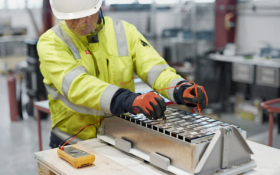Electric vehicle sales are growing, albeit steadily, and so are the discussions surrounding what to do with the lithium-ion packs that power them.
One school of thought is to recover the valuable metals. But, as delegates at the International Congress for Battery Recycling heard, this can be expensive and tricky.
Attendees at this year’s event on the shores of Lake Geneva, Switzerland, were told in no uncertain terms that recycling metals from batteries was a price issue.
Dr Dieter Offenthaler, CEO at Batrec Industrie, said recycling could achieve anything, but only if companies were willing to pay for it. “The question is what do we want it to achieve and how much are we willing to pay for it,” he said.
The sentiment echoed a comment made earlier in the conference, which gave the simple equation: the amount of metals that can be recovered from batteries is equal to the amount of money and time a company invests.
Dr Michel Monteil, Federal Office for the Environment, Management Waste and Resources in Switzerland, said cost would drop once enough lithium batteries came on to the recycling market.
So will lithium-ion recycling ever be a good investment? The jury is out, but until more end-of-life lithium-ion batteries come onto the recycling stream the cost of recovering the metals will remain high.
So another alternative is to re-use the packs—or second-life applications, to use the correct term.
On paper, this makes sense, especially when you consider that firms predict batteries will still have 80% capacity remaining as the vehicle comes to its natural end of life.
This year has seen a raft of energy storage systems being unveiled by OEMs —GM, Daimler and Nissan spring to mind—to reuse their electric vehicle battery packs.
But this has not convinced Christophe Pillot, from Avicenne Energy. He told the conference his firm was not considering second-life batteries because it didn’t know if the market would even exist in the future.
“If the battery has 80% of capacity left, I’m not sure if it is easy to reuse in other applications for different reasons,” he said.
“For example, all the cells have to be at the same level [of capacity] for safety reasons. I’m not saying the second-life market will never exist but for [recent] forecasts we don’t see any impact.”












